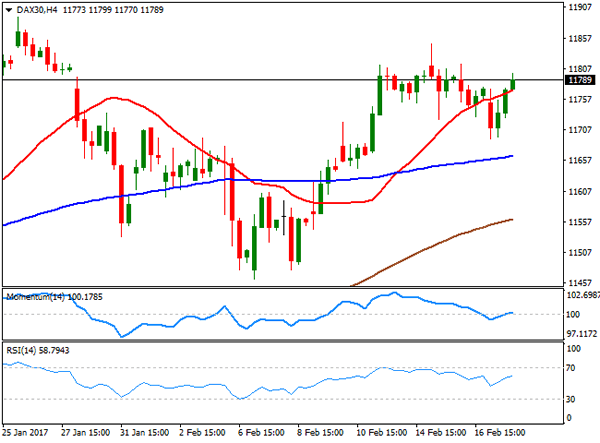EUR/USD
The dollar received a vote of confidence late last week, advancing against most of its major rivals with the clear exception of the JPY, as data released during these last few days indicated a rebound in inflation and economic activity, whilst FED’s head Yellen hawkish testimony before the Congress, boosted chances of a rate hike in March. The common currency, on the other hand, remained undermined by political woes, as adding to the upcoming elections were rising concerns about Greece, still struggling to meet austerity requirements to get bailouts. This upcoming week will start with a banking holiday in the US, anticipating some choppy trading across the board, although next Tuesday, the release of February preliminary PMIs figures in both economies could set the tone for the whole week.
The EUR/USD pair closed on Friday at 1.0610, pretty much flat when compared to its previous weekly close, and is technically poised to extend its decline during the upcoming days, given that in the daily chart, advances were contained by a bearish 100 DMA, around 1.0680, whilst the Momentum indicator maintains a strong bearish slope within negative territory, and the RSI indicator resumed its decline after a tepid upward correction, also developing within bearish levels. In the 4 hours chart, the price settled a few pips below a flat 20 SMA, while the RSI indicator turned flat around 44 and the Momentum indicator retreats from overbought readings, still above its 100 level. The key for the upcoming days is the Fibonacci support at 1.0565, as renewed selling interest below the level will open doors for an extension sub-1.0500.
Support levels: 1.0590 1.0565 1.0520
Resistance levels: 1.0650 1.0680 1.0720
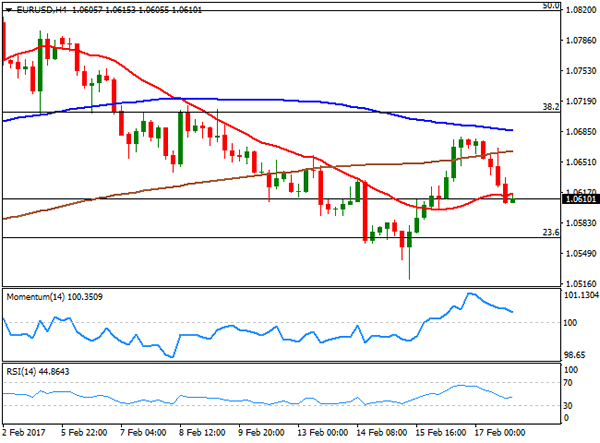
USD/JPY
The USD/JPY pair trimmed all of its previous week gains after a failed attempt to surge beyond 115.00, resuming the bearish trend that began with the year. The pair topped at 114.95 last Wednesday, when a hawkish FED’s Yellen opened doors for a rate hike in March. And while US stocks surged to record highs, US yields were unable to hold on to gains, and finished the week near February lows. Also, supporting the yen is the ongoing political uncertainty in Europe and the US that at the end of the day pushes speculative interest into safe-haven assets. From a technical point of view, the daily chart shows that the pair is holding a few pips above its 100 DMA currently around 112.45, while a major Fibonacci support comes at 111.95. In the same chart, technical indicators have turned south around their mid-lines, but lack enough downward momentum to confirm a bearish extension. In the shorter term, and according to the 4 hours chart, the bearish bias is firmer, as indicators maintain their sharp bearish slopes within negative territory, whilst the price has settled below bearish 100 and 200 SMAs, with the shortest acting as dynamic resistance around 113.40.
Support levels: 112.45 112.10 111.60
Resistance levels: 113.00 113.40 113.85
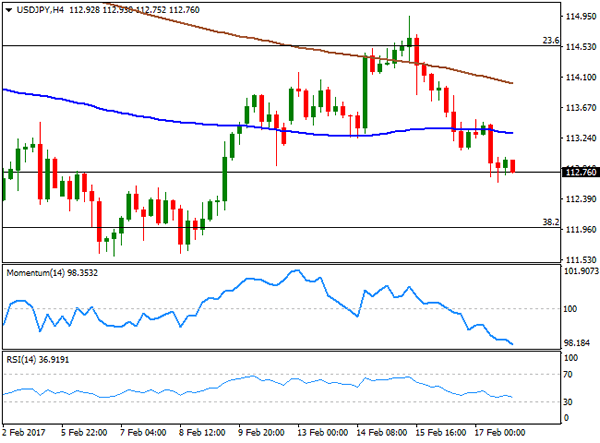
GBP/USD
After spending the week struggling to regain the 1.2500 level, the GBP/USD pair plunged on Friday, following the release of much worse-than-expected UK Retail Sales figures. Sales declined 0.3% in January, while excluding fuel, rose by 0.2% in the month, well below market’s expectations. Year-on-year, sales rose by 1.5% against the 3.4% advance expected, while ex fuel sales grew by just 2.6%. December readings suffered downward revisions, adding to evidence that rising inflation is finally affecting consumption in the UK. The daily chart for the pair shows that it settled below 1.2430, the 38.2% retracement of the latest bullish run, while technical indicators resumed their declines within negative territory. Early attempts to break higher were contained by a now modestly bearish 20 SMA, currently at 1.2510. In the 4 hours chart, the price is also developing below its 20 SMA which converges with a horizontal 200 EMA around 1.2460, while the Momentum indicator turned lower within neutral territory, but the RSI heads south around 36, maintaining the risk towards the downside. February low at 1.2346, at the 50% retracement of the mentioned rally, is the level to break to confirm a new leg lower sub-1.2200 for these next few days.
Support levels: 1.2380 1.2345 1.2300
Resistance levels: 1.2430 1.2460 1.2510
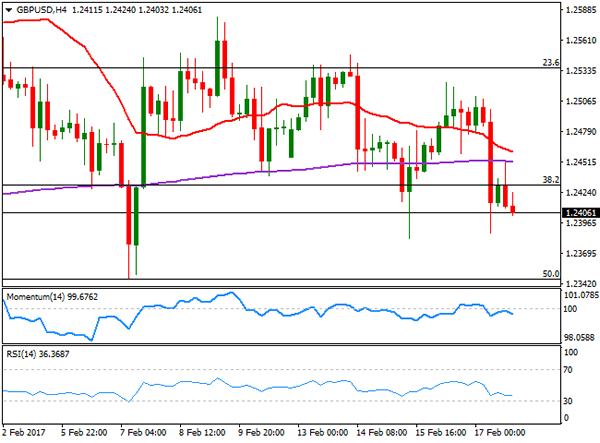
GOLD
Spot gold closed with gains for a third consecutive week, although off its February highs as the dollar gained momentum ahead of the weekly close. The bright metal settled at $1,235.57 a troy ounce, posting a solid recover from a low of 1,1216,64, which followed Yellen’s statement. The upward momentum seems to be slowing, as in the daily chart, the commodity has settled a double top around 1,244.00, with the neckline of the figure being the mentioned low, whilst technical indicators head modestly lower, within positive territory. A bullish 20 DMA offers support a few cents above the mentioned low, all of which suggests that bulls won’t give up as long as the 1,215.00 region holds. In the 4 hours chart, the metal presents a bullish stance, as the 20 SMA heads north around 1,233.90, while indicators have pared their declines well above their mid-lines and after correcting overbought conditions. A break above 1,244.60, however, will favor an extension up to 1,255.10, the 61.8% retracement of the post-US election slide.
Support levels: 1,233.90 1,222.50 1,216.60
Resistance levels: 1,244.60 1,255.10 1,261.60
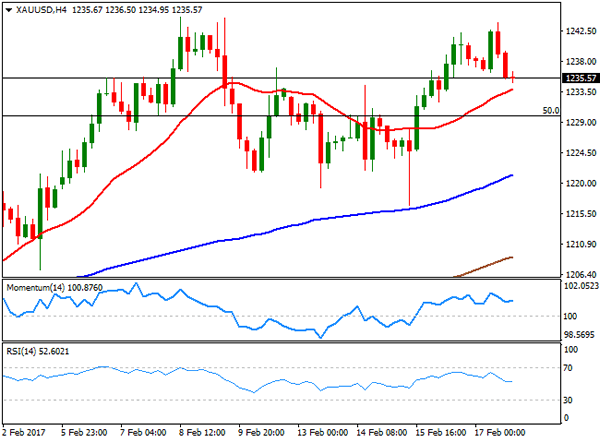
WTI CRUDE
Crude oil prices closed the week marginally lower but still within familiar ranges, with West Texas Intermediate futures settling at $53.73 a barrel. Rising US stocks and production offset the optimism surrounding the so far, successful OPEC’s output cut, leaving the commodity directionless for one more week. News on Friday showed that the number of active oil rigs increased by 6, up to 597, the highest number since early October 2015. Ever since the OPEC announced its agreement, US rigs increased by 120. The technical picture for US crude futures remains neutral, as in the daily chart, the price rests above a flat 20 DMA, while technical indicators head nowhere around their mid-lines. In the 4 hours chart, the commodity also presents a neutral stance, as moving averages remain horizontal and within a tight range, whilst technical indicators continue hovering around their mid-lines with no certain directional strength.
Support levels: 53.00 52.60 52.00
Resistance levels: 54.40 55.20 55.70
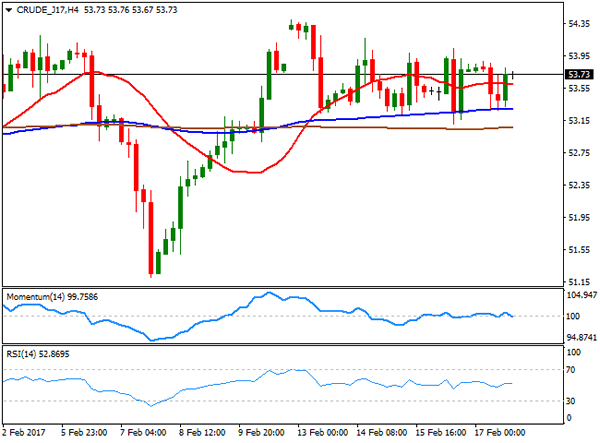
DJIA
Wall Street advanced modestly on Friday, but it was enough for the three major indexes to end at all-time highs. The Dow Jones Industrial Average closed the week at 20,624.05, adding 4 points on Friday and 1.75% for the week. The Nasdaq Composite ended at 5,838.58, after adding 23 points or 0.41%, while the S&P finished at 2,351.16, after adding roughly 4 points on Friday. Within the Dow, Verizon Communications was the best performer, up 1.51%, followed by Boeing that added 1.11%. Energy and banking-related equities were in the losing side, with Exxon Mobil down 0.66% and JPMorgan Chase shedding 0.33%. Technically the daily chart shows that the index held above far above a bullish 20 DMA, whilst technical indicators have turned flat within overbought territory, limiting chances of a downward move. In the 4 hours chart, the benchmark stands above a bullish 20 SMA, the RSI indicator holds flat around 69, but the Momentum indicator diverges lower, heading sharply lower around 100 and presenting a bearish divergence still to be confirmed.
Support levels: 20,552 20,506 20,467
Resistance levels: 20,652 20,700 20,750
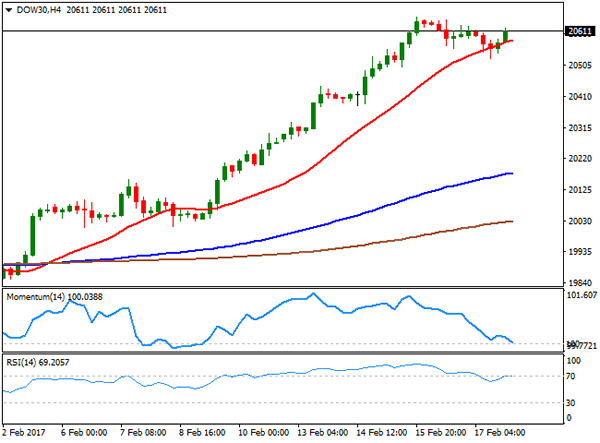
FTSE 100
The FTSE 100 added 22 points or 0.30%, to close the week at 7,299.96, with food-related equities offsetting banks and mining equities´ declines, after Kraft Heinz Co. announced a merger proposal that Unilever decline. The bid was of £112 billion, the fourth-biggest in corporate history, resulting in Unilever adding 13.43% to top winners’ list. Coca-cola followed through, up 4.03%. In the losing side, Standard Chartered was the worst performer, down 4.36%, followed by Rolls Royce that shed 3.97% and Royal Dutch Shell that closed 1.80% lower. From a technical point of view, the benchmark presents a bullish stance, as it is holding above a bullish 20 SMA, while the Momentum indicator heads higher within positive territory, and the RSI indicator consolidates around 64, this last reflecting the limited intraday ranges seen lately rather than suggesting upward exhaustion.
Support levels: 7,291 7,254 7,208
Resistance levels: 7,354 7,390 7,430
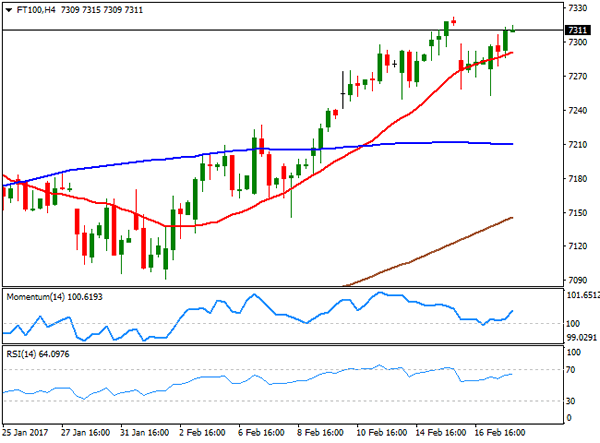
DAX
The German DAX closed flat at 11,757.02 last Friday, as the banking sector underperformed over growing uncertainty, while mining and energy equities also edged lower. Volkswagen was the worst performer, down 1.81%, while Deutsche Bank lost 1.16% and Commerzbank 1.15%. Encouraging earnings reports, on the other hand, provided net support to the index, which ended the week up by 0.77%. Technically, the index presents a neutral-to-bullish stance, given that in the daily chart, the benchmark held above a modestly bullish 20 SMA, but technical indicators continue to lack directional strength. In the 4 hours chart, the index closed the week with a modest positive tone, as it settled a few points above a bullish 20 SMA, whilst technical indicators have entered positive territory, with clear upward slopes. A recovery beyond 11,800 will open doors for a retest of this year high at 11,891.
Support levels: 11,728 11,694 11,640
Resistance levels: 11,800 11,848 11,891
